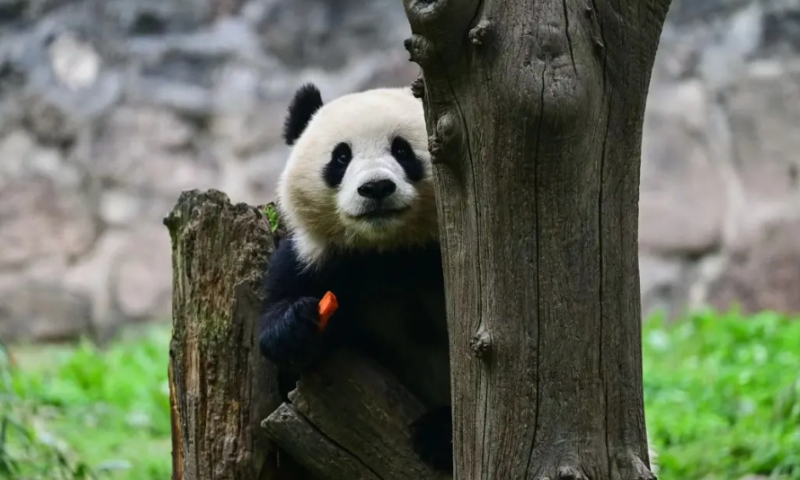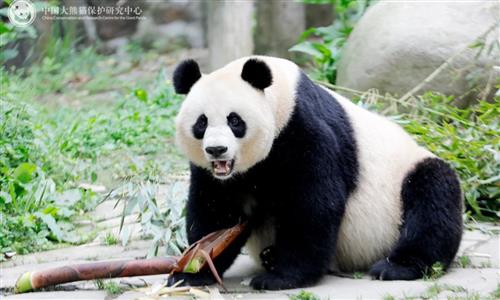China continues giant panda protection cooperation with the US; two adolescent pandas to be sent to the national zoo in Washington DC

Qing Bao Photo: WeChat account of China Wildlife Conservation Association
China and the US have embarked on a fresh round of collaboration in giant panda conservation and research. As part of this initiative, a pair of adolescent pandas is expected to be sent to the national zoo in Washington DC by the end of this year.
In a statement released on Wednesday by the China Wildlife Conservation Association (CWCA), it was announced that the association has entered into a new agreement with the Smithsonian's National Zoo for cooperation in giant panda research. Two new adolescent pandas, including 2-year-old male panda Bao Li (born in August 2021) and 2-year-old female panda Qing Bao (born in September 2021), will make their way to the zoo later this year. This marks the return of pandas to the US zoo since the departure of the last bears for China in November last year.
Giant pandas have been one of the biggest attractions at the Smithsonian's National Zoo ever since the first pair arrived in 1972 - a historic token of friendship from China.
For decades, China has gifted or loaned pandas to zoos around the world. However, China stopped renewing panda loans to the US zoos in recent years. Atlanta is currently the last zoo in the US to have giant pandas, and they are set to return to China.
In February, the CWCA reached the agreements with the zoos in overseas countries in a new round of international cooperation for giant panda conservation, including with the San Diego Zoo in the US, according to Xinhua News Agency.
The pair of 2-year-old giant pandas heading to Washington DC were both born at the China Conservation and Research Center for the Giant Panda in Southwest China's Sichuan Province.
Bao Li has the Washington DC roots with his mother Bao Bao born at the Smithsonian's National Zoo in 2013 and was sent back to China in 2017. Bao Li's grandparents, Tian Tian (male) and Mei Xiang (female), lived at the zoo for 23 years, before being returned to China last year.
Mei Xiang and Tian Tian arrived at the Smithsonian's National Zoo in 2000 and their fourth cub, Xiao Qi Ji, was born in 2020. Xiao Qi Ji's siblings returned to China when each of them was two or three years old.
According to CWCA, in order to ensure the two giant pandas' healthy living condition in the US, Chinese experts visited the US three times in the first half of this year to provide guidance on facility renovations and conduct technical consultations. They specified the standards and requirements for facility conditions, feeding management, food supply, and health care of the giant pandas.
The Smithsonian's National Zoo in Washington DC has undergone renovations and upgrades to enhance the living conditions of the two giant pandas, ensuring a more comfortable and secure environment. The facility has been equipped with experienced full-time keepers, a professional veterinary team, and a scientific research team, the CWCA said.
According to CWCA, both China and the US are committed to strictly adhering to the standards and technical guidelines for the care and management of giant pandas. They will further enhance the care and management of giant pandas living in the US by conducting regular health monitoring, on-site inspections, and assessments to ensure the health and safety of the pandas traveling abroad.
The association conducted the first round of giant panda research cooperation with the Smithsonian's National Zoo between 2000 and 2023, according to CWCA. During this period, the two sides established a strong working relationship and achieved significant results in various areas, including giant panda conservation and breeding, disease treatment, technical exchanges, personnel training, and public education.
With their collaborative efforts, the zoo successfully bred four panda cubs, namely Tai Shan, Bao Bao, Bei Bei, and Xiao Qi Ji.
Meanwhile, the association and the zoo have jointly published 115 professional books and over 300 academic papers. They have trained more than 1,500 professionals in wildlife animal conservation, both from China and abroad. Their efforts in science popularization and education, through both offline and online channels, have reached hundreds of millions of people worldwide. This cooperation has also played a positive role in promoting cultural exchange between China and the US, and in fostering mutual understanding and friendship between the peoples of the two countries.
The association is confident that the new round of international cooperation on giant panda conservation between China and the US will build upon their already strong collaboration and achieve further advancements in various areas, including major disease prevention and treatment, epidemic prevention and control, scientific and technological exchanges, as well as support for wild giant panda conservation and the establishment of giant panda national parks. It is anticipated that this cooperation will make significant contributions to global biodiversity conservation and strengthen the friendship between the peoples of both countries.
Global Times


